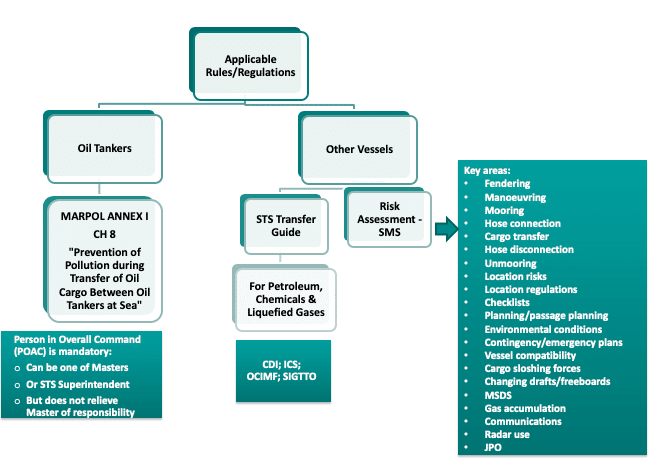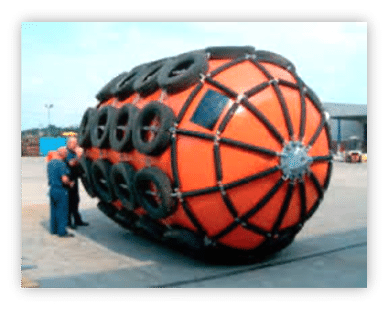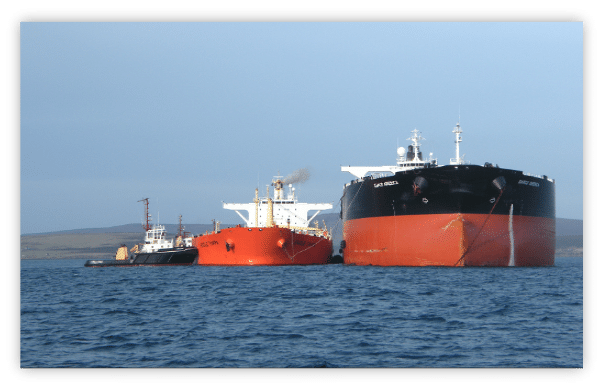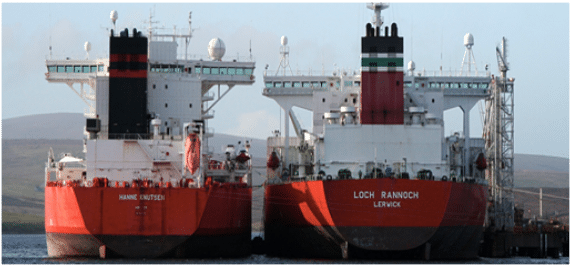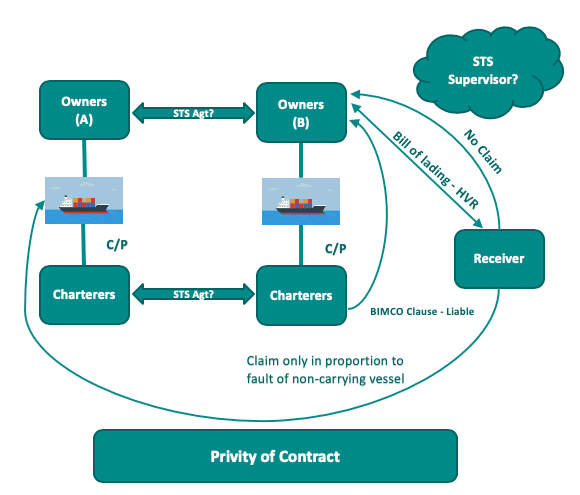Are STS “Collisions” Collisions at all?
Are STS “Collisions” Collisions at all? – Points to Note with STS Damage Claims
The first question that arises with an STS collision is – is it a “collision” at all?
Intuitively, it does not feel like a collision. Indeed, in many instances, the vessels are already joined together with mooring equipment. Therefore, it may not seem correct to refer to this as a “collision”. However, for many legal purposes, the word “collision” has a wider, more encompassing meaning. The Civil Procedure Rules (“CPR”), which govern the procedure for court actions in England and Wales, effectively defines a “collision claim” to include:
“…any action to enforce a claim for damage, loss of life or personal injury arising out of…the carrying out of or omission to carry out a manoeuvre in the case of one or more of two or more ships; or non-compliance…with the collision regulations”
Importantly, there is no requirement (or mention) for actual contact. Therefore, under English law, the meaning of a collision claim can encompass such matters as one vessel being damaged by the wash of another vessel without any contact. For example, in The Batavier III [1], the Bromsgrove was securely moored at the Deptford Buoys, River Thames. The Batavier III came by at speed and her wash carried away the Bromsgrove towards the banks requiring her to be salved. This, in effect, was held to be a collision claim. That said, care needs to be taken in other contexts – for example, for a claim to be considered as a “collision claim” under an ITCH hull policy, there must be actual contact.
Therefore, any damage caused by a ship to another ship during an STS operation is likely to be classified as a “collision claim”.
Consequences of an STS Situation being Classified as a “Collision Claim”
In the first instance, there are a number of significant issues that will be affected by the relevant claim being classified as a collision claim. For a more detailed discussions on the issues relevant to collision claims see our article: Collisions – Pitfalls, Banana Skins and Tips. In summary, care must be taken to ensure that the following issues have been adequately considered and/or dealt with:
- Is there a jurisdiction agreement to the underlying collision?
- Do I also need to commence proceedings (not just a defence) to protect my counter-claim?
- Beware that answers given in Part 1 of the Collision Statement of Case will be treated as admissions – admissions that cannot be easily changed at a later point.
- The use of Nautical Assessors, and the resulting limited influence that the parties can exercise on the Nautical Assessors. Those affected should consider whether to:
- Make an application to the Court to treat the relevant STS collision matter not as a “collision claim” for the purposes of the CPR; and
- Potentially, to challenge the use of Court appointed Nautical Assessors under Article 6 of the European Convention on Human Rights (i.e. the right to a fair trial).
Rules and Regulations Applicable to STS Operations
When determining liability, consideration should be given to the rules and regulations that may be applicable to a particular STS operation. Some examples include:
- In relation to oil tankers, there are specific requirements contained in MARPOL Annex 1 Chapter 8 “Prevention of Pollution during Transfer of Oil Cargo Between Oil Tankers at Sea”; and
- In relation to petroleum, chemical and liquefied gas carriers, the industry (acting through the trade bodies CDI; the ICS; OCIMF; and SIGTTO) has produced an industry STS Transfer Guide. When it is taken into account that, ICS (the International Chamber of Shipping) have approximately 80% of the world’s merchant fleet in their membership, it would be foolish of anyone involved in an STS operation to ignore these guidelines – even in respect of other vessel types.
The following areas are worthy of particular mention and will often be fertile areas for dispute:
Fendering
The above is a photograph of a commonly used pneumatic air fender (otherwise known as a “Yokohama fender”). There are relevant standards (for example ISO standards) that apply to such equipment and, where relevant, compliance with these standards should be checked. Fendering will generally be in place along the parallel body between the vessels. Secondary fendering will also be in place to help protect the vessels during docking and undocking. All of these arrangements will need to be adapted to suit the vessels involved and the manoeuvres being undertaken.
Manoeuvring/joining
There are many different ways in which two vessels may come together for an STS operation. One vessel may be moored, one vessel may be anchored, or the two vessels may be moving along together. Obviously, different considerations apply to each of these different circumstances.
Mooring against an anchored vessel deserves particular mention. Although this may seem relatively straightforward, given the natural tendency of anchored vessels to change heading and sheer, this can actually be amongst the trickiest of manoeuvres. In many cases, the vessels will come together while both vessels are making headway. They will then join together before one of the vessels will bring their engines to a halt, with the other vessel then undertaking and controlling the anchoring procedure.
Mooring lines
Particular care is needed in the mooring arrangements (including quick release arrangements). In particular, where there is a significant height difference between the two vessels, this will necessarily mean the lengths of mooring lines will be much longer and, therefore, the moorings arrangements will naturally be less stable.
Vessel Compatibility
Perhaps surprisingly, one situation in which the vessels will be incompatible is where they are virtually identical. For example, their bridge wings will be in the same location and potentially very close to one another. As can be seen in the photo above, very little movement in the way of swells would cause the bridge wings to come into contact. In this regard, it should be noted that, for example, long powerful swells (not necessarily visible to the naked eye) would present a significant collision risk.
Local requirements
In addition, it is always important to check what local rules and regulations may be in place in the relevant area/port. These requirements may go above and beyond those contained in the above requirements/guides – and will probably be mandatory. Where they exist, they must be followed.
The Various Claims
The Charterparty
In the context of STS operations pursuant to a charterparty interesting questions can arise in relation to the distinction between instructions as to “employment” of the vessel and instructions as to “navigation” of the vessel. In the context of a time-charterparty, the critical distinction between employment and navigation as highlighted by cases such as The Hill Harmony [2] comes to the fore.
In the case of The Erechthion [3], it was stated that orders to proceed to an anchorage to lighten were orders as to employment, whereas advice given by the pilot as to exactly where to anchor, were matters of navigation. The court held that an implied indemnity will only generally apply to orders as to employment and not to orders as to navigation. Therefore, there is a significant risk in an STS collision that owners will be left with no recourse under an implied indemnity if the matters involved come within the master’s/owner’s realm of responsibility under “navigation”.
As a result of these issues, an express indemnity will often be provided for under the charterparty − for example, using the BIMCO STS Clause. Arguably, even some of these express indemnities do not go far enough and (depending on whether the matter is considered from the charterers’ or the owners’ perspective) tighter wording may be desired.
Cargo
Usually, where a collision is involved, under English law, the cargo interests will be limited to claiming their losses from the relevant vessels in proportion to the degree of fault of that vessel (Section 187 of the Merchant Shipping Act 1995).
Because many contracts of carriage will encompass the Hague/Hague-Visby Rules, the exception of “act, neglect, or default of the master, mariner, pilot, or the servants of the carrier in the navigation … of the ship”, and the exception of “perils, dangers and accidents of the sea or other navigable waters” may prevent the cargo interests from bringing any claim against the carrying ship. In these circumstances the cargo interests will have to look to their insurers for the unrecovered losses. The position is somewhat different in the US, where the cargo interests are often able to claim in full against either of the ships at fault (bringing into play a “both-to-blame” clause).
Personal Injury/Death Claims
It should be noted that the rule appearing under section 187 does not apply in relation to personal injury/death claims – in these circumstances, the injured party can claim their full claim from either vessel (Section 188 of the Merchant Shipping Act 1995) – leaving the vessels involved to claim contributions from each other.
STS Agreements – Between Charterers
It may well be the case that there is an STS agreement in place between two relevant charterers of the vessels undertaking an STS operation. If that is the case, they may well provide for mutual waivers of liability between each other, and they may also provide for undertakings not to bring any actions as against the relevant owners involved. In such circumstances, generally speaking, provided certain rules are followed, such arrangements can be valid and enforceable under English law as between the charterers. The relevant owners may well be able to enforce any such provisions in their favour in accordance with the provisions of the Contracts (Rights of Third Parties) Act 1999.
What happens if those STS agreements between charterers purport to prevent the relevant owners from bringing a collision claim against the other owner involved? The simple answer is that any such provisions made without the consent of the relevant owners will be ineffective. This is due to the principle of ‘privity of contract’. Therefore, where any STS agreement is simply between charterers, that would be ineffective to bind owners with any obligations or restrictions of their rights (regardless of whether owners may be able to take advantage of any clauses in their favour, as referred to above).
STS Agreements – Between Owners
Where an STS agreement exist as between the relevant owners, it is perfectly possible for those to be enforceable in full as between those owners. Therefore, where appropriate wording has been used, that may indeed prevent a collision claim from being brought, but that needs to be specifically agreed between these entities.
Insurance Provisions
Some insurers require that any STS activities are reported to them, and that the approval of the relevant insurer is obtained before the STS operation is carried out. Other insurers have no such requirements. In these circumstances, insurers are generally left in a position of having to argue that there has been a non-disclosure or a failure to make a fair presentation of the risk.
STS Supervisor
Given the complexities of STS operations, the parties will often employ the services of an STS supervisor – who should be particularly experienced in such matters.
Where an independent STS supervisor is used, that does not detract from the master’s duty to maintain the safety of the vessel, or his overall responsibility for preventing collisions or other dangerous situations arising.
In terms of any liability being brought against an STS supervisor, usually such supervisors will only provide services on the basis of standard wording that will attempt to relieve them of majority of such liabilities. Provided that clear and sufficient wording is used, such exemptions/limitations of liability are largely enforceable under English law, at least in respect of property damage.
STS Collisions – Conclusion
Although STS collisions at first sight may not seem to be “collisions” in the true sense of the word, legally they are often classified as such.
This means that a whole host of specialist rules and procedures will automatically apply, and careful handling and forethought needs to go into managing the claim so that some of the less desirable aspects of collision claims do not bite. In this respect, please see our article The Stolt Kestrel [2015] EWCA Civ 1035 – Lessons learned!
Hindsight is a wonderful thing, but STS operations are inherently risky and, where possible, proper consideration should be given in relation to the relevant operational, contractual and insurance provisions before such operations are entered into.
Collisions – Pitfalls, Banana Skins and Tips
The above gives the main issues relevant to collision claims involving an STS transfers. Nevertheless, there are further issues to be considered. For a fuller picture of issues, please see our article Collisions – Pitfalls and Banana Skins and Tips!
[1] (1925) 23 Ll.L. Rep 21
[2] [2001] 1 Lloyd’s Rep. 147
[3] [1987] 2 Lloyd’s Rep. 180



